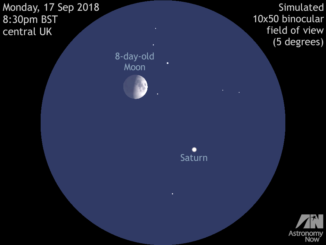
Moons like Tethys (660 miles or 1,062 kilometres across) are large enough that their own gravity is sufficient to overcome the material strength of the substances they are made of (mostly ice in the case of Tethys) and mould them into spherical shapes. But small moons like Janus (111 miles or 179 kilometres across) are not massive enough for their gravity to form them into a sphere. Janus and its like are left as irregularly shaped bodies.
Saturn’s narrow F ring and the outer edge of its A ring slice across the scene.
This view from the NASA/ESA/ASI Cassini spacecraft looks toward the unilluminated side of the rings from about 0.23 degrees below the ring plane. The image was taken in visible green light with the spacecraft’s narrow-angle camera on 27 October 2015.
The view was obtained at a distance of approximately 593,000 miles (955,000 kilometres) from Janus. Image scale at Janus is 3.7 miles (6 kilometres) per pixel. Tethys was at a distance of 810,000 miles (1.3 million kilometres) for an image scale of 5 miles (8 kilometres) per pixel.



